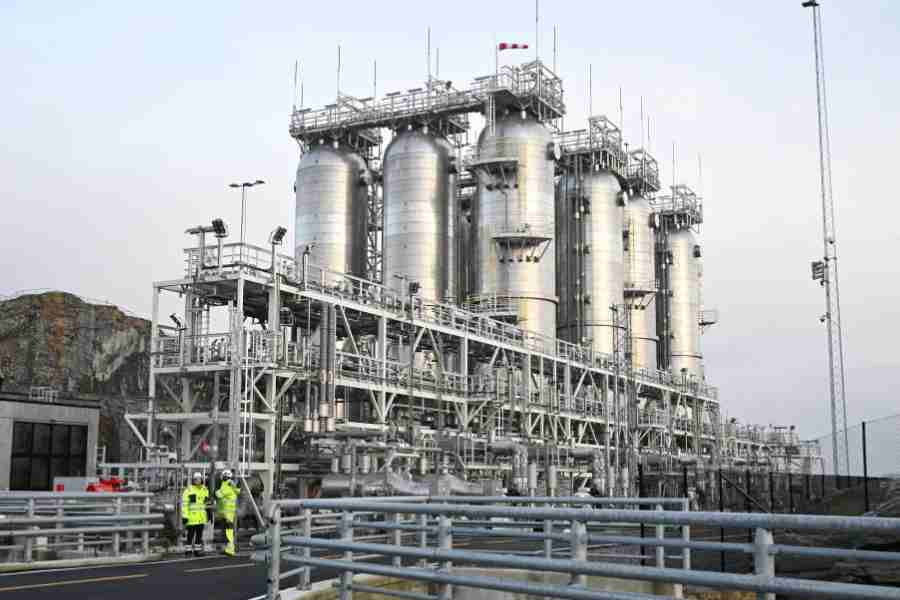This summer, Bill Gates huddled in London with representatives of some of the world’s wealthiest people, including Amazon founder Jeff Bezos, SoftBank founder Masayoshi Son and Prince al-Waleed bin Talal of Saudi Arabia.
They were evaluating their joint investments in companies that could help the world combat climate change. Among the businesses in their portfolio, four stood out as having a particularly audacious goal: They were working to strip carbon dioxide from the atmosphere, for a profit.
As countries around the world continue to pump planet-warming pollution into the skies, driving global temperatures to record levels, the financial world is racing to fund the emerging field of carbon dioxide removal, seeking both an environmental miracle and a financial windfall.
The technology, which did not exist until a few years ago, is still unproven at scale. Yet, it has a uniquely alluring appeal. Stripping away some of the carbon dioxide that is heating up the world makes intuitive sense. And with a small but growing number of companies willing to pay for it, investors are jockeying to be first movers in what they believe will inevitably be a big industry that is necessary to help fight global warming.
Companies working on ways to pull carbon dioxide from the air have raised more than $5 billion since 2018, according to the investment bank Jefferies. Before that, there were almost nosuch investments.
“It’s the single greatest opportunity I’ve seen in 20 years of doing venture capital,” said Damien Steel, the chief executive of Canada-based Deep Sky, which has raised more than $50 million to develop carbon dioxide removal projects. “The tailwinds behind the industry are greater than most industries I’ve ever looked at.”
The group assembled by Gates, known as Breakthrough Energy Ventures, is among the biggest backers of the more than 800 carbon removal companies that have been started in recent years. Other investors include Silicon Valley venture capitalists, private equity firms from Wall Street and major corporations like United Airlines.
Investors believe the market is poised forexplosive growth.
More than 1,000 big companies have pledged to eliminate their carbon emissions over the next few decades. As part of those efforts, more corporations are starting to pay for carbon dioxide removal. This year, Microsoft, Google and British Airways were among the companies that committed a total of $1.6 billion to purchase removal credits.
That figure was up from less than $1 million in 2019, according to CDR.fyi, a website that tracks the carbon dioxide removal industry. Next year, industry executives believe companies could spend up to $10 billion on such purchases. In a recent report, McKinsey estimated the market could be worth as much as $1.2 trillion by 2050.
While huge sums of money are being dedicated to the nascent field, these projects will not have a meaningful effect on global temperatures anytime soon.
There are a few dozen facilities operational today, including ones in Iceland and California. But the biggest of these capture only a sliver of the greenhouse gases humans produce in one day. Even if hundreds more such plants were built, they would not come close to counteracting even 1 per cent of annual carbon dioxide emissions.
“Let’s not pretend that it’s going to become available within the time frame we need to reduce emissions,” said former Vice-President Al Gore, a co-founder of Climate Trace, which maps global greenhouse gas emissions.
Last year, a United Nations panel cast significant doubt on the industry’s ability to make a difference. “Engineering-based removal activities are technologically and economically unproven, especially at scale, and pose unknown environmental and social risks,” it said.
Instead, many scientists and activists say the most effective way to combat global warming is to rapidly phase out oil, gas and coal, the burning of which is heating the planet.
“We need to obey the first law of holes,” Gore said. “When you’re in one, stop digging.”
Carbon dioxide removal is the most developed form of what is known as geoengineering, a broad set of speculative technologies designed to manipulate natural systems in order to cool the planet. In the past several years, as climate change has worsened, such ideas have moved from the stuff of science fiction into the mainstream.
Other proposed plans include changing the chemistry of the world’s rivers and oceans to absorb more carbon dioxide, genetically altering bacteria to reduce greenhouse gas emissions from agriculture, and reflecting sunlight away from Earth by brightening clouds or spraying sulfur dioxide into the stratosphere.
But it is carbon dioxide removal that is attracting the big money.
Investors believe that, while the impact on temperatures may be negligible in the short term, the industry will start to make a difference as global emissions fall and the technology becomes more powerful.
Decades from now, even if the world is able to completely eliminate all new greenhouse gas emissions, many experts, including the Intergovernmental Panel on Climate Change, a scientific body convened by the United Nations, believe it will still be necessary to remove some carbon dioxide from the atmosphere to reduce global temperatures.
Critics argue that carbon dioxide removal is a dangerous distraction that will perpetuate the behaviour that is causing the climate crisis.
“Carbon capture will increase fossil fuel production, there’s no doubt about it,” said Mark Z. Jacobson, a professor of civil and environmental engineering at Stanford University. “It does not help climate one bit.”
But for now, neither investors nor customers are shying away.
A group of companies, including Stripe, H&M, J.P. Morgan and Meta, have banded together to make more than $1 billion in purchase commitments for carbon dioxide removal. Other companies, including Airbus, Equinor and Boeing, have pledged to pay for the service, too.
Some companies are trying to offset their emissions. Some see value in helping to develop a new industry they might one day profit from. And some say they are simply trying to do the right thing.
“This isn’t intrinsically tied to our day-to-day business,” said Nan Ransohoff, the head of climate at Stripe, an online payments company that is coordinating the group purchasing. “But we care a lot about progress and trying to help the world move in the right direction.”
The US government is supporting the industry. The Inflation Reduction Act more than tripled the tax credit for capturing and storing carbon removed directly from the atmosphere, to $180 per tonne. The bipartisan infrastructure law signed by President Joe Biden in 2021 included $3.5 billion for the creation of four demonstration projects.
Executives don’t believe that the carbon dioxide removal industry will be knocked off course by President-elect Donald J. Trump, who has called climate policies a “scam” and has said he wants to roll back many of Biden’s climate initiatives.
Support for the new technology “has been very bipartisan”, said Noah Deich, who until recently was the deputy assistant secretary of carbon management at the energy department.
New York Times News Service











